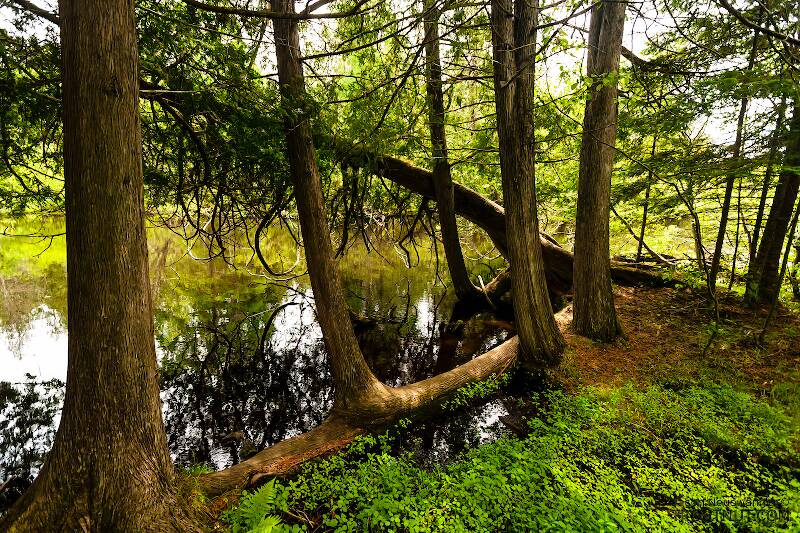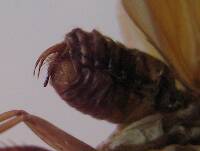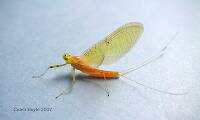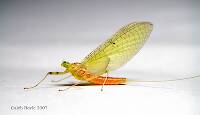
Blue-winged Olives
Baetis
Tiny Baetis mayflies are perhaps the most commonly encountered and imitated by anglers on all American trout streams due to their great abundance, widespread distribution, and trout-friendly emergence habits.
Featured on the forum

This one pretty clearly keys to Kogotus, but it also looks fairly different from specimens I caught in the same creek about a month later in the year. With only one species of the genus known in Washington, I'm not sure about the answer to this ID.

Troutnut is a project started in 2003 by salmonid ecologist Jason "Troutnut" Neuswanger to help anglers and
fly tyers unabashedly embrace the entomological side of the sport. Learn more about Troutnut or
support the project for an enhanced experience here.
Quillgordon on Apr 10, 2007April 10th, 2007, 1:27 am EDT
Jason,
You have done a great job with your website. I remember when you first started and I was 'amazed' by your insect photos. I wish my father were here today to see your collection/photos of all the insects. My father and his buddies were into entomology back in the 50's when I first started to flyfish.
My question(finally) is:" What general guidelines would you use to accurately match the hatch while fishing?" Should I have a camera with me and try to identify the exact or almost exact insect hatching? I don't have a camera now( plan on buying one soon), so I try to catch a newly emerged dun or caddis and try to match size,shape, and color. This can be difficult at times!
My home stream doesn't have a large variety of insects, mostly 'stones', bwo's, and caddis. I mostly fish caddis and bwo emergers.
Any input from you/others would be appreciated.
John
You have done a great job with your website. I remember when you first started and I was 'amazed' by your insect photos. I wish my father were here today to see your collection/photos of all the insects. My father and his buddies were into entomology back in the 50's when I first started to flyfish.
My question(finally) is:" What general guidelines would you use to accurately match the hatch while fishing?" Should I have a camera with me and try to identify the exact or almost exact insect hatching? I don't have a camera now( plan on buying one soon), so I try to catch a newly emerged dun or caddis and try to match size,shape, and color. This can be difficult at times!
My home stream doesn't have a large variety of insects, mostly 'stones', bwo's, and caddis. I mostly fish caddis and bwo emergers.
Any input from you/others would be appreciated.
John
Flyfishing is a state of mind! .............. Q.g.
C/R........barbless
C/R........barbless
Troutnut on Apr 10, 2007April 10th, 2007, 2:31 am EDT
Welcome to the site. :)
Size, shape, color, and observed hatching behavior are certainly important, and matching them will get you a long way. The main reasons for learning entomology are less significant, but still worthwhile:
Even with a camera it's hard to identify the exact insect hatching unless it's a major widespread hatch. Just look around this site for all the specimens labeled with a family or genus name instead of species -- that's because we haven't been able to identify them down to the species level. It can be pretty hard.
I would still encourage you to carry a camera, photograph your hatches, and post them here in the "Get Bugs Identified" forum; the above paragraph is just to temper your expectations. I'll try to get an article up soon about how to take good pictures for identification, but here are the basics: get top, bottom, and side views, as close-up as you can. If it's a nymph, you can skip the side view, but photograph it in the water against a uniform background (even cupped in your palm will work, as long as it's submerged).
By the way, even if you don't get your hatches perfectly identified, your photos can serve as a valuable guide when you're tying imitations.
Size, shape, color, and observed hatching behavior are certainly important, and matching them will get you a long way. The main reasons for learning entomology are less significant, but still worthwhile:
- It lets you match the appearance and behavior of the unseen stages of the insect you're seeing, and sometimes those are the ones the trout key on, especially the nymphs or pupae.
- It helps you fill in the blanks about behavior of the insect that might be difficult to observe over the short time you're watching. For example, should you fish a dun or an emerger? It depends on how long the species takes to emerge, and how long it sits on the water afterward.
- It gives you some expectation of what will happen on any given day, so you know what flies to bring and so you have a little sense of what will happen next on the stream. Say you saw a bunch of duns coming off -- when can you expect them to return as spinners?
- It's just fun. This is the real reason. The other two are excuses to make it seem less frivolous.
Even with a camera it's hard to identify the exact insect hatching unless it's a major widespread hatch. Just look around this site for all the specimens labeled with a family or genus name instead of species -- that's because we haven't been able to identify them down to the species level. It can be pretty hard.
I would still encourage you to carry a camera, photograph your hatches, and post them here in the "Get Bugs Identified" forum; the above paragraph is just to temper your expectations. I'll try to get an article up soon about how to take good pictures for identification, but here are the basics: get top, bottom, and side views, as close-up as you can. If it's a nymph, you can skip the side view, but photograph it in the water against a uniform background (even cupped in your palm will work, as long as it's submerged).
By the way, even if you don't get your hatches perfectly identified, your photos can serve as a valuable guide when you're tying imitations.
Jason Neuswanger, Ph.D.
Troutnut and salmonid ecologist
Troutnut and salmonid ecologist
Quillgordon on Apr 10, 2007April 10th, 2007, 3:04 am EDT
Jason,
Thank you for the quick reply!
I have read many of the posts/photos of the insects. I recently read the posts about the Bwo/s, quill gordon,and the caddis(tan) on the Tulpohocken. I understand its difficult to identify down to the 'species' level. If I could get the 'family' name correct, I would be happy....... just for my own personal satisfaction.
Since I mostly fish caddis patterns, I want to start there!
Most of the caddis here are tan. My records show they first appear around April first. Its a light tan(wings)caddis with an olive green body. The larva I see all have a 'turtle-shell-like case(saddle-case maker) of stone/sand, so I think they are the genus 'Glossosoma'. I'm quessing they are the 'little tan short horn sedge'..... my reference is 'Caddisflies' by Gary LaFontaine. what a great book!
Does this sound right?
John...
Flyfishing is a state of mind! .............. Q.g.
C/R........barbless
C/R........barbless
GONZO on Apr 10, 2007April 10th, 2007, 1:43 pm EDT
Hi John,
The cases you are seeing do sound like Glossosoma, but I'd be very surprised if you didn't have some free-living (like Rhyacophila) and net-spinning (like Hydropsyche/Ceratopsyche or Cheumatopsyche) larvae as well. These don't make cases (except as temporary pupation shelters), but they are very important most everywhere.
I wouldn't underestimate the value of being able to identify the inverts that are significant in your home streams, especially if those streams are home to fussy, hatch-conscious or pressured fish. If you can identify the important larvae, you can anticipate the hatches. This allows you to break the frustrating cycle of constantly being surprised by important activity and desperately trying to match it with something that may or may not be in your box.
Although it seems too complicated for some anglers, and it is unnecessary on some streams, this approach actually has the benefit of simplifying fly fishing considerably. You can go to the stream knowing what to expect and prepared to match it. You'll catch more fish this way, and your relationship with your homewaters will become more intimate and interesting.
The cases you are seeing do sound like Glossosoma, but I'd be very surprised if you didn't have some free-living (like Rhyacophila) and net-spinning (like Hydropsyche/Ceratopsyche or Cheumatopsyche) larvae as well. These don't make cases (except as temporary pupation shelters), but they are very important most everywhere.
I wouldn't underestimate the value of being able to identify the inverts that are significant in your home streams, especially if those streams are home to fussy, hatch-conscious or pressured fish. If you can identify the important larvae, you can anticipate the hatches. This allows you to break the frustrating cycle of constantly being surprised by important activity and desperately trying to match it with something that may or may not be in your box.
Although it seems too complicated for some anglers, and it is unnecessary on some streams, this approach actually has the benefit of simplifying fly fishing considerably. You can go to the stream knowing what to expect and prepared to match it. You'll catch more fish this way, and your relationship with your homewaters will become more intimate and interesting.
Quillgordon on Apr 11, 2007April 11th, 2007, 1:52 am EDT
Gonzo,
Thank you for your reply...... enjoy reading your posts and others. As other posters have stated; "how do you guys remember all this taxonomy stuff". I spent two(2)yeras at the Univ. Conn. in biology, but I don't think I would have gotten a degree in entomology, if I had to memorize order/family/genus/species particulars.
I'm sure you are correct about 'Hydropsyche' and 'Rhyacophila'. All the 'Glossosoma' I found were near shore; I found them by lifting small rocks! I would have better luck trying to photograph adults ,, I would think.
Is there a website that lists caddis in Pa. by counties? I have the Penn. St.(Eire) website in my 'documents', but now you need a password to get entry, so I can't observe that info now. If I recall, there were no caddis listings for Schuylkill County.
Do you suggest I photograph the adults for best identification?
Respectfully,
John
Thank you for your reply...... enjoy reading your posts and others. As other posters have stated; "how do you guys remember all this taxonomy stuff". I spent two(2)yeras at the Univ. Conn. in biology, but I don't think I would have gotten a degree in entomology, if I had to memorize order/family/genus/species particulars.
I'm sure you are correct about 'Hydropsyche' and 'Rhyacophila'. All the 'Glossosoma' I found were near shore; I found them by lifting small rocks! I would have better luck trying to photograph adults ,, I would think.
Is there a website that lists caddis in Pa. by counties? I have the Penn. St.(Eire) website in my 'documents', but now you need a password to get entry, so I can't observe that info now. If I recall, there were no caddis listings for Schuylkill County.
Do you suggest I photograph the adults for best identification?
Respectfully,
John
Flyfishing is a state of mind! .............. Q.g.
C/R........barbless
C/R........barbless
Troutnut on Apr 11, 2007April 11th, 2007, 6:36 am EDT
You don't really need to sit down and memorize the scientific names. Just read up on the interesting parts of entomology (how the different bugs behave, finding pictures to tie imitations, etc) and the names will rub off. You learn them in the same way you pick up street names in your home town, not by sitting down to memorize a list, but by seeing them repeatedly in context.
Case in point, I'm terrible at rote memorization, but I've got most of the names down pretty well. I've tried to make this site facilitate that learning process by showing common and scientific names together wherever possible.
Case in point, I'm terrible at rote memorization, but I've got most of the names down pretty well. I've tried to make this site facilitate that learning process by showing common and scientific names together wherever possible.
Jason Neuswanger, Ph.D.
Troutnut and salmonid ecologist
Troutnut and salmonid ecologist
GONZO on Apr 11, 2007April 11th, 2007, 6:41 am EDT
John,
Like anything, you tend to remember the things that interest you. But we clearly don't remember it all--at least, not accurately. ;)
If you need help with identification, posting your pictures here is a great idea. I wouldn't focus just on the adults. If you can identify the larvae, you'll have a better chance of anticipating the hatch.
That's a bummer about the Masteller site. Taxon has some great distribution search tools on his site, but I don't know if you can search by county.
Best,
Gonzo
How do you guys remember all this taxonomy stuff?
Like anything, you tend to remember the things that interest you. But we clearly don't remember it all--at least, not accurately. ;)
If you need help with identification, posting your pictures here is a great idea. I wouldn't focus just on the adults. If you can identify the larvae, you'll have a better chance of anticipating the hatch.
That's a bummer about the Masteller site. Taxon has some great distribution search tools on his site, but I don't know if you can search by county.
Best,
Gonzo
Taxon on Apr 11, 2007April 11th, 2007, 8:40 am EDT
John-
Thanks for alerting me that the Pennsylvania Aquatic Insects website is no longer accessible without a logon and password. I fired off an email to Dr. Masteller early this morning requesting one, and will let you know what the response is, if I’m lucky enough to get one.
One other possibility would be the NatureServe Explorer website. However, thus far I haven't been able to get any listings when doing their search by county. Not sure whether they simply don't carry county detail for Trichopteran species, or if I'm just not doing it right.
Thanks for alerting me that the Pennsylvania Aquatic Insects website is no longer accessible without a logon and password. I fired off an email to Dr. Masteller early this morning requesting one, and will let you know what the response is, if I’m lucky enough to get one.
One other possibility would be the NatureServe Explorer website. However, thus far I haven't been able to get any listings when doing their search by county. Not sure whether they simply don't carry county detail for Trichopteran species, or if I'm just not doing it right.
Quillgordon on Apr 11, 2007April 11th, 2007, 8:41 am EDT
Jason,
You don't really need to sit down and memorize the scientific names. Just read up on the interesting parts of entomology (how the different bugs behave, finding pictures to tie imitations, etc) and the names will rub off. You learn them in the same way you pick up street names in your home town, not by sitting down to memorize a list, but by seeing them repeatedly in context.
******************************************************************
I was referring to getting a degree in 'Entomology'. I know most of the common names and some 'scientific'(latin) names of the insects that hatch here. Well I did, until they started changing them!
I was just trying to zero-in on the caddis families where I fish.
Gonzo,
I definately need a camera for identification! If I see something hatch I try to grab one to check size and color. Unless you get a good look , these caddis 'critters' look all alike!
* I saw no caddis or mayflies today, only midges! Something doesn't seem right this year!
Thanks guys....
You don't really need to sit down and memorize the scientific names. Just read up on the interesting parts of entomology (how the different bugs behave, finding pictures to tie imitations, etc) and the names will rub off. You learn them in the same way you pick up street names in your home town, not by sitting down to memorize a list, but by seeing them repeatedly in context.
******************************************************************
I was referring to getting a degree in 'Entomology'. I know most of the common names and some 'scientific'(latin) names of the insects that hatch here. Well I did, until they started changing them!
I was just trying to zero-in on the caddis families where I fish.
Gonzo,
I definately need a camera for identification! If I see something hatch I try to grab one to check size and color. Unless you get a good look , these caddis 'critters' look all alike!
* I saw no caddis or mayflies today, only midges! Something doesn't seem right this year!
Thanks guys....
Flyfishing is a state of mind! .............. Q.g.
C/R........barbless
C/R........barbless
Taxon on Apr 11, 2007April 11th, 2007, 9:17 am EDT
John-
Got a prompt response from Dr. Masteller thanking me for visiting the site, and assuring me it was back up now. Apparently the logon screen simply resulted from the site being down.
In any event, the Pennsylvania Aquatic Insects lists the following species for Schuylkill county:
Lepidostoma griseum
Limnephilus submonilifer
Banksiola dossuaria
Got a prompt response from Dr. Masteller thanking me for visiting the site, and assuring me it was back up now. Apparently the logon screen simply resulted from the site being down.
In any event, the Pennsylvania Aquatic Insects lists the following species for Schuylkill county:
Lepidostoma griseum
Limnephilus submonilifer
Banksiola dossuaria
GONZO on Apr 11, 2007April 11th, 2007, 9:37 am EDT
Hmmm...surely there are more species than that, but it's great to know that the Masteller site is available again! :)
Quillgordon on Apr 11, 2007April 11th, 2007, 9:40 am EDT
Taxon,
Thank you....... I just checked it, and I was able to get in.I thought maybe I needed clearance by the University. I like the idea of showing the insects by county.
I also checked your website...... I didn't realize the caddis link was at the top. You did a very nice job. I see the table listing of caddis...... very informative.
I'm pretty sure that 'Glossosoma' should be on that list for Schuylkill County.
Thank you!
John...
Thank you....... I just checked it, and I was able to get in.I thought maybe I needed clearance by the University. I like the idea of showing the insects by county.
I also checked your website...... I didn't realize the caddis link was at the top. You did a very nice job. I see the table listing of caddis...... very informative.
I'm pretty sure that 'Glossosoma' should be on that list for Schuylkill County.
Thank you!
John...
Flyfishing is a state of mind! .............. Q.g.
C/R........barbless
C/R........barbless
Taxon on Apr 11, 2007April 11th, 2007, 10:52 am EDT
I'm pretty sure that 'Glossosoma' should be on that list for Schuylkill County.
John-
Certainly wouldn't be surprised, as both Glossosoma intermedium and G. nigrior are listed for PA by Query N. American Caddisfly Distribution.
Quick Reply
Related Discussions
Topic
Replies
Last Reply
3
May 21, 2008
by Greenwolly
by Greenwolly






